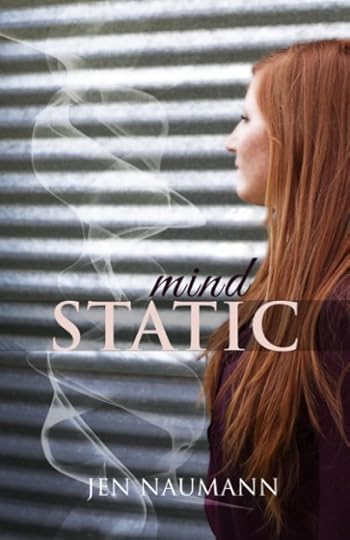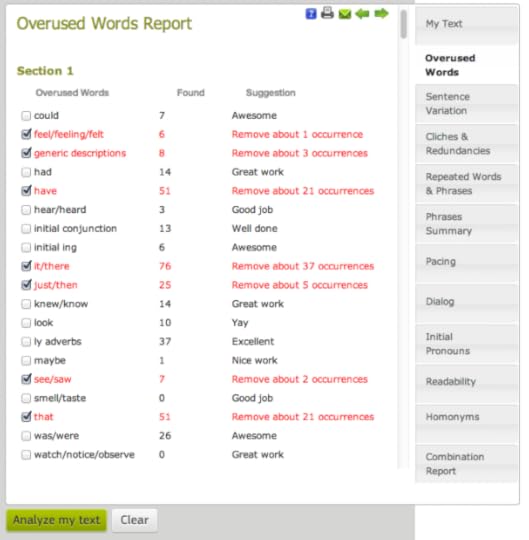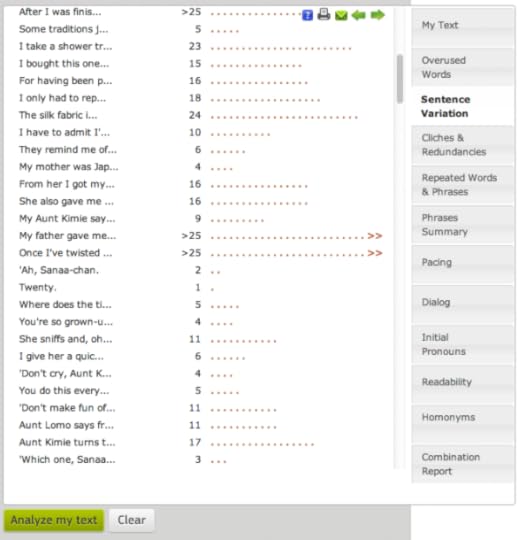S.J. Pajonas's Blog, page 165
August 5, 2013
Sanaa and her katana
It’s time for the first promotional image for REMOVED, Book ONE of the Nogiku Series. There will be a new one each Monday leading up to the launch of the book on September 16, 2013.

Sanaa and her katana
Images will also be posted to Tumblr, Twitter, and Facebook. Please spread them around!
August 2, 2013
Cover Reveal: Mind Static by Jen Naumann
I’m grateful for all the new authors friends I’ve been making on Twitter and through FB groups. I do have a wide variety of author friends from YA to erotica (which is always good fun on Twitter!) but what matters most is that we all love our craft and help each other out.
Today, I’m bringing you Jen Naumann’s new YA paranormal, MIND STATIC.

MIND STATIC by Jen Naumann
Although life has been pretty good to Keyanna Sanders, the day she turns eighteen she’s about to get everything she could ever wish for—a hot guy who’s really into her, a sporty car she’s always dreamed of owning, and the party of a lifetime that no one will forget any time soon.
But before long, she’ll understand these wishes are more than a coincidence, and that they come at a steep price. Keyanna is more than just an average high school senior, her best friend is more than the innocent boy next door, and her sudden good fortune isn’t just by chance. When her estranged father suddenly re-enters her life, she’ll have to decide who to trust, and whether or not the man she loves has suddenly become the enemy.
Sounds intriguing, no? Expected publication date is THIS month, August 2013, so go queue her work on Goodreads, ok?
Find Jen Naumann on her website, Goodreads, Amazon, Twitter, Facebook.
July 29, 2013
Copy editing with AutoCrit

This vacation was my reward for copy editing REMOVED because it was a long, hard road, my friends.
The process of bringing a book to readers is arduous. You have to have an original idea, write it eloquently, figure out all the things wrong and make them right, get test readers, revise, more test reading, more revising. You get my drift, right? It’s not something that happens in a few months. It can take years! And if you decide to get an agent and then get traditionally published, the process can take even longer.
Let’s say you get to your 8th or 9th draft, you’ve revised, you’ve beta tested, you’ve workshopped, and now you want to self-publish (the idea of getting an agent or traditionally published doesn’t appeal to you). Your novel is awesome! And you want to put it out there, right? Have you line edited your manuscript yet? Copy edited? Do you know what that means?
Line editing is the process of evaluating your manuscript for tone and style. Honestly, I’m going to assume that by the 6th, 7th, 8th or 9th draft, you have this down pat. You have a writing style, and you use it consistently. If you feel that you don’t, you may want to ask for help here because line editing is a bigger issue than I can deal with in this post. If you feel that your manuscript is consistent, your last two steps before publishing will be copy editing and proofreading.
Copy editing is the process of formatting a manuscript’s grammar and language accuracy. Plenty of writers are great storytellers but don’t know shit about grammar. Commas misplaced. Wrong idioms used. Sentence fragments everywhere. You can completely turn off a reader from your story by getting these things wrong, so you’ll get them right, right?
I’ve broken this process into three phases. It’s up to you which of the first two phases you conquer first. They can be switched. This is my personal preference.
Phase 1 of copy editing
Let me point you to a few sites you should memorize and get to know before copy editing:
A grammar primer for writers and self-publishers – I wrote this post on my tumblr a while back. It links to all of the grammar posts on Beth Revis’s blog. If you don’t know Beth, you should! She’s an excellent writer. Memorize the rules contained in this post. Know the difference between dependent and independent phrases and where to put commas in your sentences. DO NOT PLACE COMMAS WILLY NILLY. Jesus, nothing drives me more nuts than that.
Coordinating vs subordinating conjunctions – learn the difference between these two conjunctions, and you’ll be a step ahead of the game! Knowing what each does and why will also help you place commas correctly. Compound sentences are an important part of your manuscript. Varying sentence length is important to keeping your reader engaged.
Homophones – I’m going to mention this one specifically because it’s the one I struggle with the most! Homophones are words that sound the same but have different spellings and meanings, like role/roll, reign/rein/rain, wracked/racked, bare/bear. If you reach a word in your manuscript and think, Hmmm, maybe that’s a homophone, LOOK IT UP. Don’t just trust your gut, please!
Idioms and phrases – I love idioms (you should see the book of Japanese idioms I have at home. They are hilarious!) An idiom is a common phrase that’s well-known to a native speaker. Remember, that these vary by region, so if you’re a Northerner writing about a Southerner, you should probably do some research about common phrases uttered in the South before considering your manuscript complete. But even common idioms should be looked up! In my last manuscript, I used the phrase “just desserts” and was surprised to find that this originated as “just deserts” first. Let me say this again, every time you use a common phrase, LOOK IT UP. It’s “once in a while” not “once and a while” (ugh, I saw that one in a NYT best seller!). It’s “rack your brain” not “wrack your brain.” If you’re describing an event as depressing and sad, it’s the “gravity” of the situation, not “levity.” I swear to god I saw that in a recent manuscript. WHY? Don’t trust your gut. DOUBLE CHECK EVERY TIME.
And here is a list of some other random articles I looked up while revising this last book:
Parentheses – Grammar and punctuation – I always have trouble deciding which to use: parentheses, em dashes, or just commas.
Who vs Whom
Conditional sentences – If/then
When to use “onto”
“Wracking” or “racking” your brain
A while vs Awhile
Ok, that’s how to get started. Evaluate every sentence (yes, I know that’s tedious, but it’s only the beginning). Once you get the hang of seeing the dependent and independent phrases and the conjunctions, you’ll start writing cleaner in your first draft instead of your 10th draft.
Once you’re happy with sentence structures, it’s time to save and backup your manuscript and move onto phase 2 of copy editing.
Phase 2 of copy editing
I’m recommending something that costs money, and I know many self-publishers are on a tight budget. It’s worth it. Get yourself a subscription at AutoCrit.com. I have the Platinum membership because I like to plug in a chapter at a time for analyzing. It’s only $77 per year! That’s nothing. I’m sure you can make that money back in no time.
AutoCrit’s name is misleading. It is not a critique of your manuscript. You should have done that already. NO ONE WRITES IN A VACUUM. If you haven’t let other people read your work and give you critiques, you shouldn’t even consider publishing your work. My first novel, REMOVED, has been through 10 drafts. It has been read and critiqued by over 40 beta readers. It was agented. It was on submission! I wouldn’t dream of putting it out there without feedback. All the other novels in the series have been read by outsiders too. If you need critiques, get a critique group or a crit partner who is willing to give you real feedback.
AutoCrit is going to do something for you most human beings can’t do, it’s going to show you overused and repetitive words and phrases, sentence length, pacing, cliches, and a whole host of other details you may find useful. These are all items the human brain tends to skip over but begin to nag at the reader’s subconscious after a while, pulling her out of the story. She’ll be two or three chapters into a story and wonder why the author keeps using the same phrase over and over! Boom! She’s out of the story, back to reality, and that’s no good.
Let me show you what happened when I plugged my first chapter into AutoCrit. This was draft NINE.

Yikes! Look at all that RED!
Clearly, I have a love for the words “that”, “just”, “it/there”, and a few other things. All of these items are words that can be removed from your manuscript to make the writing stronger.
Let’s start from the bottom:
Most of the time, you can just eliminate “that” from a sentence, and the sentence will still make sense. If you’re not sure, read the sentence out loud.
Too many “I see” “I saw” “He saw” etc in a manuscript indicates you are telling the story instead of showing it. Rewrite the sentence and eliminate it.
“Just/then” these can also be deleted from sentences unless it’s a dialogue quirk of your character. A lot of us say “just,” and we don’t even know it. Keep the dialogue real but delete these words from your descriptive text.
“It/there” is the hardest one for me. Sometimes the prose flows easier using it. Sometimes it’s better to use “there” because it feels more natural. But my advice is to read each sentence with “it” and see if you can’t replace “it” with a better descriptor. Example: I set the katana back in the box. Holding it frightened me and excited me at the same time. Change this to: I set the katana back in the box. Holding the long and heavy sword frightened and excited me at the same time. See? Better. (Totally lame example, I know).
“Have” is so hard to get rid of for me. I write in first person present tense, and “have” is a natural part of my writing style. Do your best here.
“Generic descriptions” are, just that, generic. “Really” “maybe” “great” “good” can all usually be replaced by better synonyms. Get out your thesaurus! I manage to eliminate a lot of these except for some “Really?” in dialogue.
“Feel/feeling/felt” are also ways in which we tell the story and not how we show. Example: Sakai stares at me in silence, and I feel uncomfortable under his harsh glare. Change that to: Sakai stares at me in silence, and under his harsh glare, I’m uncomfortable enough to squirm in my seat. Better!
There are more things AutoCrit will call out to you, but I managed to stay within an acceptable limit on those items. Many writers will just change “saw/see” to “notice/watch/observe” and AutoCrit will catch those too. Sneaky! Once you’re done fixing everything in red (you can turn the items on/off with checkboxes if you want to do them a pass at a time), run your new text through.

Much better!
See, I didn’t eliminate everything. I got them down to what I felt were acceptable levels within my style and story and called that portion of copy editing complete.
BUT YOU’RE NOT DONE! There are other tabs along the side to look at. Sentence Variation is nice. It’ll show you the length of sentences, and you can decide to chop up longer sentences if you have many in a row. Or maybe combine some shorter sentences to vary things? It’s up to you. I like my chapters to flow in and out, like a wave.

Short to long and back again.
The next most helpful tab is definitely the Repeated Words & Phrases. This is what my chapter looked like before I edited it.

Oops! There’s a lot that can be changed here.
Look at that! I see plenty of things I can change in there. I can rewrite a sentences to eliminate “while” which I used in two adjacent paragraphs. I can use my thesaurus to describe the kimono better and eliminate at least one use of “orange.” This was just a snippet of text. The whole chapter needed a sweep through.
You’ve completed Phases 1 and 2! You’ve gone through every chapter, fixed sentence structures, and then used AutoCrit to get rid of overused and repetitive words, added variation to sentence structure, and analyzed the pace. You’re done, right?
Nope.
Phase 3 of copy editing
Get a different set of eyes to proofread. Have someone who is not you, and you trust to be an eagle eye (I ask my mom and an English teacher friend) read everything over and make sure you didn’t accidentally delete a word or punctuation or a paragraph. This is important! By now, you are probably sick of looking at your manuscript! You need a break! Get outside help. Pay them in coffee, cookies, yarn, what have you.
Now, go out there and make your manuscript go from great to stellar!
July 22, 2013
Announcement: REMOVED, Book ONE of the Nogiku Series, Coming September 2013
I’ve kept this news off the blog, Twitter, and Facebook, but now is the time to make my announcement. I decided in June to take my books back from my agent and navigate the world of publishing by myself for the time being. Yes, I’m self-publishing! Which won’t come as a shock to many of you, I’m sure. It was a hard decision to make. This book, REMOVED, was on submission as a Young Adult novel, and I just wasn’t getting the kind of feedback I was looking for. A lot of editors said they loved it, but it wasn’t the right book for them or it competed with other authors they already represented. It was frustrating to hear from my 30+ beta readers, my agent, and some editors that the book was great, but it couldn’t find a place. Maybe if I had stuck out the submissions process for another few years an indie press would pick it up? Maybe…
I had an idea. What if I’m the indie press? Sure, I don’t have the far-reaching contacts or budget, but I know I’ll find my readers somehow. I don’t want this series to die. None of my beta readers want to see it die either, so I’m charging forth.
When I took the book back, I made another big decision. I aged it up out of Young Adult and into the New Adult genre. Now, my main character, Sanaa, is 20 and all of her peers are in their 20s. They’re struggling with love and marriage, responsibility, honor and loyalty, doubts and anxiety due to their circumstances. These novels make more sense to me now! And I’m proud to be bringing them to you all. Each of the four novels in the series will be published every 4-6 months. I will not make you wait years to see the outcome. You’re welcome.

REMOVED, Book ONE of the Nogiku Series. Coming September 2013.
Duty knows no family. Love has no price. Secrets can cost you everything.
Twenty-year-old Sanaa Griffin, a sweet and smart half-Japanese girl, is about to get more than she bargained for when she wishes for love and excitement on New Year’s Eve 3103. Mark Sakai, who knows more about her than any stranger should, thinks Sanaa is the perfect person to spy on the heads of the three biggest Japanese clan leaders in Nishikyō. He wants her to gather enough evidence to keep them from going to war when they land on Earth’s colonization planet, Yūsei. Nishikyō, built by the Japanese 300 years ago to house the rest of mankind, is failing and everyone is preparing to leave.
Sakai has known Sanaa’s family all her life but she knows nothing of him! And despite all the time they spend together, he keeps his distance from her. Then one day, he brings her to Jiro, his nephew, to learn sword fighting, and it changes her life irrevocably. Between falling in love with Jiro and the information she is gathering on the clans, Sanaa realizes Sakai is holding back secrets about her family and her deceased parents, secrets as to why she was chosen for this job, and learning the truth puts her and all of Nishikyō in danger.
COMING SEPTEMBER 2013 to Amazon, Barnes & Noble, and Kobo. Electronic copies only. Sorry, no paperbacks at this time. [ETA: I may be offering paperbacks through Createspace! A new blog post about that soon!]
For news updates, please either keep an eye here on my blog or follow me on Twitter @spajonas. For news updates about the Nogiku Series ONLY, please follow @NogikuSeries. The NogikuSeries Twitter will give updates about publishing dates, sales, reviews, and relevant blog posts. You can also use the Newsletter Signup (located at the bottom of every page of the website) if you prefer to get your news by email. ETA: Forgot about my Facebook author page! Like me there!
As soon as the book is published (I’m shooting for September 16th but the day may fluctuate depending on Amazon/BN/Kobo approval), I’ll be able to create a Goodreads author account and make it available on Goodreads for queuing and reviews! I’ll let you know.
And in the next blog post, I’ll write about my editing process for getting these books ready for actual readers.
July 16, 2013
Sideways Shawl
When I attended NE SCBWI’s conference in May, I was working on a big knitting project, The Sideways Shawl. I was really close to having it complete and didn’t want to leave it at home, so I brought it with me. I knit on it during breaks and in a couple of workshops that I didn’t need to take notes in. I knit on it after eating and before bed at night in my hotel room. Then it was done! And I took a photo of it on the hotel room floor  Heh. It’s a huge shawl especially with the DK weight yarn I used. More like a blanket than anything else. I love it, though. It’s going to be great in the winter!
Heh. It’s a huge shawl especially with the DK weight yarn I used. More like a blanket than anything else. I love it, though. It’s going to be great in the winter!

This shawl is huge! I could barely get it all in the photo.
Click through to the Flickr and Ravelry pages for more information on this knit.

I love the way the stripes swoop down across the back.
I am sad to say that I lost my knitting mojo right after completing it. I started on a Hitchhiker shawl but then got swamped with work. All I want to do in the evenings is stare into space! I’ve been watching a lot of Korean dramas with a heating pad on my upper back between my shoulders. I’ve spent the last month slaving away over the line edits of my book that will be published in September (more on that at the end of July) and need to rest my arms and hands when I can.
Hopefully my knitting mojo will be back by the end of summer, and I can pick up the slack on my 8 in 2013 projects!



